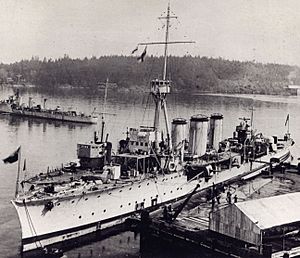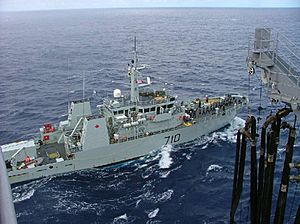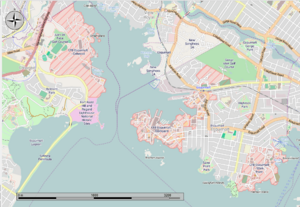CFB Esquimalt facts for kids
Quick facts for kids CFB Esquimalt – former Esquimalt Royal Navy Dockyard |
|
|---|---|
| Esquimalt, British Columbia, Canada | |
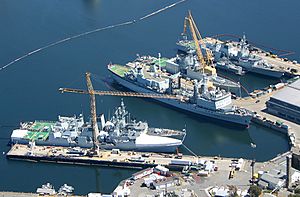
Canadian naval ships docked at CFB Esquimalt
|
|
| Coordinates | 48°25′52″N 123°25′54″W / 48.43111°N 123.43167°W |
| Type | Naval base |
| Site information | |
| Controlled by | Canadian Forces |
| Site history | |
| Built | 1860 to present |
| In use | 1860 –present |
| Battles/wars | |
| Official name: Esquimalt Naval Sites National Historic Site of Canada | |
| Designated: | 1995 |
| Garrison information | |
| Garrison | Royal Canadian Navy |
Canadian Forces Base Esquimalt (often called CFB Esquimalt) is Canada's main naval base on the Pacific Coast. It's where many of Canada's navy ships are based. This important base is home to the Royal Canadian Navy's Pacific fleet. As of 2018, over 4,400 military members and 2,700 civilians work here.
Contents
Where is CFB Esquimalt?
The base covers about 41 square kilometers (10,000 acres). It is located at the southern tip of Vancouver Island. This area is right on the Strait of Juan de Fuca. The base is in the town of Esquimalt, next to Victoria. Victoria is the capital city of British Columbia.
What's at the Base?
CFB Esquimalt has many important facilities. These include Naden, which is a training area. There is also Her Majesty's Canadian (HMC) Dockyard Esquimalt. This is where ships are repaired and maintained. The base also has a school for firefighting and damage control. The Naval Officer Training Centre (NOTC) Venture is also here. This is where future naval officers learn their skills. The base also provides housing for military families.
The HMC Dockyard Esquimalt is very old. It started as the Royal Navy's Esquimalt Royal Navy Dockyard in 1842. It was the Royal Navy's main base in the Pacific until 1911. Today, it is Canada's main naval headquarters for the Pacific Ocean.
What Units Work Here?
Many important units are part of CFB Esquimalt. These units help the navy operate smoothly. They also support other Canadian Forces activities.
- Campus Pacific
- Fleet Diving Unit (Pacific) (Navy divers)
- 443 Maritime Helicopter Squadron (Helicopters for naval operations)
- Canadian Forces Health Services Centre (Pacific) (Medical care)
- Naval Provost Marshal (Pacific) (Military police)
- 5th (British Columbia) Field Artillery Regiment, RCA
- The Canadian Scottish Regiment
- 11 Service Battalion
- 4th Canadian Rangers Patrol Group
- Acoustic Data Analysis Centre
- Regional Cadets (Pacific) (Cadet programs)
A Historic Place
CFB Esquimalt is a very important place in Canadian naval history. Four areas within the base have been named National Historic Sites. These are the Dockyard, the old Royal Navy Hospital, the Veterans' Cemetery, and the Cole Island Magazine. This shows their importance to Canada's past.
Ships at CFB Esquimalt
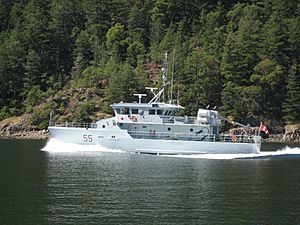
As of March 2013, CFB Esquimalt is home to many ships. These ships are part of the Canadian Fleet Pacific. They include:
- Halifax-class frigates: These are large patrol ships.
- HMCS Vancouver (FFH 331)
- HMCS Regina (FFH 334)
- HMCS Calgary (FFH 335)
- HMCS Winnipeg (FFH 338)
- HMCS Ottawa (FFH 341)
- Kingston-class coastal defence vessels: Smaller ships used for coastal patrols.
- HMCS Nanaimo (MM 702)
- HMCS Edmonton (MM 703)
- HMCS Whitehorse (MM 705)
- HMCS Yellowknife (MM 706)
- HMCS Saskatoon (MM 709)
- HMCS Brandon (MM 710)
- Victoria-class patrol submarines: These are submarines used for patrols.
- HMCS Victoria (SSK 876)
- HMCS Corner Brook (SSK 878)
- HMCS Chicoutimi (SSK 879)
- Auxiliary vessels: These ships help support the fleet.
- CFAV Tillicum (YTM 555) (a tugboat)
- Fire-class fireboat (fireboats)
- CFAV Firebrand (YTR 562)
- Ville-class tugs (tugboats)
- CFAV Lawrenceville (YTL 590)
- CFAV Parksville (YTL 591)
- Glen-class tugs
- CFAV Glendyne (YTB 640)
- CFAV Glendale (YTB 641)
- Orca-class patrol craft training tenders: These are used for training.
- Orca (PCT 55)
- Raven (PCT 56)
- Caribou (PCT 57)
- Renard (PCT 58)
- Wolf (PCT 59)
- Grizzly (PCT 60)
- Cougar (PCT 61)
- Moose (PCT 62)
Buildings and History
CFB Esquimalt has many old and important buildings. Some of these are recognized as federal heritage buildings. This means they are protected because of their history.
- Hatley Castle: This famous castle is located at the Colwood Site. It is a very important heritage building.
- Admiral's Residence: This historic home in the Dockyard was once where the naval commander lived.
- Stone Frigate Building: Another important building in the Dockyard.
- Naden Area: This area has several historic buildings. These include the Administration Block and the Catholic and Protestant Chapels.
- Work Point Barracks: This area also has old barracks buildings.
The base also has beautiful stained glass art. You can find it in the Multi-Faith Naval Chapel. There is also stained glass at the Old Naval and Garrison Church. This church is now called St Paul's Anglican.
| Lua error in Module:Location_map at line 420: attempt to index field 'wikibase' (a nil value). | |
| Location | HMCS Naden, Naden Museum Square, Building 37, Esquimalt, British Columbia |
|---|---|
The Esquimalt Naval & Military Museum is located at HMCS Naden. It is in a historic building from 1889. The museum tells the story of the navy and military in the Pacific. It shows how the Canadian Navy has grown over the years. The museum is connected to many other Canadian museums.
Other Important Facilities
CFB Esquimalt has other important areas and services:
- Bus Service: The base has its own bus service. This helps people get around the large base.
- The Lookout: This is the base newspaper. It shares news for navy members and their families.
- Albert Head Training Area: This area is about 30 kilometers (19 miles) southwest of Victoria. It is used for military training. It also hosts the Air Cadet Summer Training Centre in the summer.
- Canadian Forces Maritime Experimental Test Range (CFMETR): Located at Nanoose Bay, this facility tests naval equipment. It checks things like sonobuoys and torpedoes.
- Naval Radio Section Aldergrove: This site in the Fraser Valley handles long-distance radio communications for the navy.
- Base Fire Hall & Emergency Response Centre: This team provides firefighting and emergency services for the base and nearby communities.
Economic Impact
CFB Esquimalt is very important to the local economy.
- It brings almost $600 million into the community each year.
- It is the largest employer in the area.
- The base provides 7,866 jobs in the community.
- It spends over $770 million locally every year.


